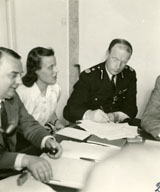Worksheet: County Chief Constable: The re-civilianisation of the German Police
Saturday 10th August: At Frankfurt I saw my first bombed town in Germany - and the papers and reports do not exaggerate. ...
Monday 12th August: Then a two hour ride South to Stuttgart, partly by autobahn and partly - owing to destroyed buildings - by very poor secondary roads. A tiring ride for it was hot and sticky and bumpy.
Tuesday 13th August: ... we drove around the town looking at the ruins, and ghastly they are too, for Stuttgart must have been a very lovely town. We also walked through the centre and visited the street black-market - about fifty evil looking men with satchels, standing under a group of trees. What they were selling I really do not know - cigarettes mostly I expect.
Wednesday 14th August: We left Stuttgart soon after breakfast and after an uneventful three hour drive, we arrived at Ansbach. ... After lunch we ... went on to Nuremberg, arriving about 4 pm. ... There are 1000-1600 people connected with the trials, and most of them are secretarial and seem to be young people between the ages of 22-40.
Thursday 15th August: ... We then went into the Court Room where we were given front seats in the visitors part. The prisoners were all in Court and evidently our uniform excited some interest for Goering looked at us hard, then turned and spoke to Ribbentrop, who also looked at us, and they then had a short conversation when Goering turned round and stared at us again for a minute or so.
Friday 16th August: We had a delightful run from Nuremburg to Munich ... we were taken by car to Dachau some ten miles away. It was a warm afternoon and the roads were bad and dusty. It is very flat land, and one sees in the distance a row of largish, rather ugly houses, with some pine woods in the background. Behind this belt of trees is the camp proper. It is a very large area, with barracks, admin offices, parade grounds, and factories in the foreground, with the prison enclosures behind and on the right flank. ... In the camp proper, there are some 16,000 SS men, of all sorts and sizes, and ...
Ref: ERICSJ/1/2/4/8
A fuller extract is available.
- Why was it necessary to go to such lengths to re-establish a civilian police force?
More questions:
Preface
Introduction
Police & WWII
The Blitz
A Volunteer
Modern Echoes
Resources
Acknowledgements
